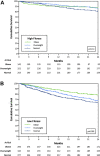Obesity, Cardiorespiratory Fitness, and Cardiovascular Disease
- PMID: 37831388
- PMCID: PMC10682063
- DOI: 10.1007/s11886-023-01975-7
Obesity, Cardiorespiratory Fitness, and Cardiovascular Disease
Abstract
Purpose of review: Obesity, generally defined by body mass index (BMI), is an established risk factor for the development of cardiovascular disease (CVD), while cardiorespiratory fitness (CRF) decreases risk. In chronic CVD, an obesity survival paradox in which higher BMI is associated with improved prognosis has been reported. This paper will examine the effect of obesity on CVD risk, explore obesity as a risk factor in patients with established CVD, and investigate the relationship between CRF, obesity, and CVD.
Recent findings: Through metabolic and hemodynamic changes, obesity increases the risk for CVD and contributes to the development of other cardiovascular risk factors such as diabetes, dyslipidemia, and hypertension. Obesity is associated with metabolic, hormonal, and inflammatory changes that leads to atherosclerosis increasing the risk for coronary artery disease, and myocardial remodeling increasing the risk for heart failure. However, it has also been observed that overweight/obese patients with established CVD have a better prognosis when compared to non-obese individuals termed the obesity paradox. CRF is a vital component of health associated with improved cardiovascular outcomes and furthermore has been shown to markedly attenuate or nullify the relationship between obesity and CVD risk/prognosis. Increasing CRF mitigates CVD risk factors and improves overall prognosis in CVD regardless of obesity status.
Keywords: Cardiorespiratory fitness; Cardiovascular disease; Obesity.
© 2023. The Author(s).
Conflict of interest statement
The authors declare that they have no conflict of interest.
Figures
References
-
- • Ogden CL, Fryar CD, Martin CB, Freedman DS, Carroll MD, Gu Q, et al. Trends in obesity prevalence by race and Hispanic origin—1999–2000 to 2017–2018. JAMA. 2020;324(12):1208–10. Public health surveillance of obesity describing changes over time and identifying subgroups at risk of obesity-related consequences. - PMC - PubMed
-
- Wang Y, Beydoun MA, Min J, Xue H, Kaminsky LA, Cheskin LJ. Has the prevalence of overweight, obesity and central obesity levelled off in the United States? Trends, patterns, disparities, and future projections for the obesity epidemic. Int J Epidemiol. 2020;49(3):810–823. doi: 10.1093/ije/dyz273. - DOI - PMC - PubMed
Publication types
MeSH terms
LinkOut - more resources
Full Text Sources
Research Materials


